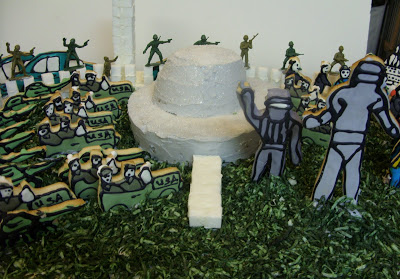I'm going to devote this post trying to dissuade readers from purchasing prepared stock. Making one's own is not only economical, it is quite simple and you have better control over the amount of sodium contained therein. You may prepare ahead for making stock by keeping a bag in the freezer into which you deposit trimmings from celery and carrots. Don't you love using every last bit of something? Glaze is a handy way to keep stock without taking up much space. It will last a few weeks and can be reconstituted into stock or used as flavouring as is. The technique works well with poultry too.
Yesterday, I made beef stock and today I intend to reduce it to meat glaze. Instructions (based loosely on the one in Mastering the Art of French Cooking) are as follows:
For beef stock:
About 3 quarts of beef bones (give or take)
Beef scraps (if the bones don't have enough)
2 peeled carrots
2 stalks of celery
2 teaspoons salt
Tied in a cheesecloth bundle:
¼ teaspoon thyme
1 bay leaf
4-5 parsley sprigs
2 unpeeled garlic cloves
2 whole cloves
In a large stockpot, cover the bones with cold water and bring slowly to a simmer-try not to let it boil as it makes for greasy stock. Begin skimming. When most of the crud (yes, "crud" is a technical term, thank you very much) has been removed, add the rest, more water and bring back to the simmer, skimming as needed. Cover with the lid permitting a couple inch gap (you don't want to make stock with a tightly fitting lid as it causes the stock to spoil). In about five hours, you have stock. Once an hour, check on it to make certain it isn't boiling or adding more water if needed. Adjust seasonings, drain through a cheesecloth-lined sieve into a bowl and let cool before de-greasing. The simplest method of de-greasing is to leave it overnight in the icebox and then skimming off the solid fat.
For the meat glaze
Using de-greased stock, bring it to the boil, uncovered in a pan and boil until it reduces to about 1 quart. Strain it through a fine sieve into a smaller pot and then continue cooking until it reduces to syrup that will coat the spoon. Take care that it does not burn. Strain it into a jar, refrigerate, and let cool completely before covering.
Subscribe to:
Post Comments (Atom)





No comments:
Post a Comment